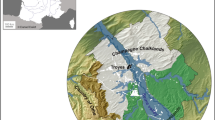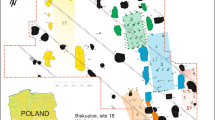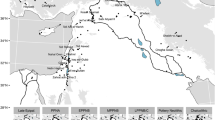Abstract
Charred plant remains from the sites of Tell Qaramel, Jerf el Ahmar, Dja’de and Tell ‘Abr situated in northern Syria and dated to the tenth and ninth millennia cal b.c. demonstrate that a wide variety of wild pulses, cereals, fruits and nuts was exploited. Five lines of evidence suggest that cultivation was practised at three of the sites. (1) Wild einkorn, wild rye and lentils occur outside their natural habitats. (2) The founder crops barley, emmer and single-grained einkorn appear at different times. (3) An assemblage of weeds of cultivation was identified. (4) There is a gradual decrease in gathered plants such as small seeded grasses and Polygonum/Rumex. (5) Barley grains increase in breadth and thickness. Morphological domestication did not become established, perhaps because seed stock was regularly collected from wild stands. Charred rodent droppings indicate large-scale grain storage.






Similar content being viewed by others
References
Bottema S (1995) The Younger Dryas in the eastern Mediterranean. Quaternary Sci Rev 14:883–891
Colledge S (1998) Identifying pre-domestication cultivation using multivariate analysis. In: Damania AB, Valkoun J, Willcox G, Qualset C (eds) The origins of agriculture and crop domestication. ICARDA, Aleppo (Syria), pp 121–131
Coqueugniot E (2000) Dja’de (Syrie), un village à la veille de la domestication (seconde moitié du 9e millénaire av. J.C.). In: Guilaine J (ed) Les premiers paysans du monde, naissance des agricultures. Paris, Errance, pp 63–79
Cucchi T, Vigne JD, Auffray JC (2005) First occurrence of the house mouse (Mus Musculus Domesticus, Schwarz and Schwarz 1943) in the Western Mediterranean : a zooarchaeological revision of subfossil occurrences. Biol J Linnaean Soc 84:429–445
de Moulins D (1997) Agricultural changes at Euphrates and steppe sites in the mid-8th to the 6th millennium B.C. BAR International Series 683, Oxford
Hillman G (2000) Plant food economy of Abu Hureyra. In: Moore A, Hillman G, Legge T (eds) Village on the Euphrates, from foraging to farming at Abu Hureyra. Oxford University Press, New York, pp 372–392
Hillman G, Davies S (1990) Measured domestication rates in wild wheats and barley under primitive cultivation, and their archaeological implications. J World Prehistory 4:157–219
Hillman GC, Hedges R, Moore A, Colledge S, Pettitt P (2001) New evidence of late glacial cereal cultivation at Abu Hureyra on the Euphrates. Holocene 11:383–393
Kislev M (1992) Agriculture in the near east in the 7th millennium B.C. In: Anderson P (ed) Préhistoire de l’agriculture. Paris: Monographie du CRA n6, Editions CNRS, pp 87–94
Kislev M, Hartmann A, Bar-Yosef O (2006) Early domesticated fig in the Jordan valley. Science 312:1372–1374
Kislev ME, Nadel D, Carmi I (1992) Epipalaeolithic (19,000 B.P.) cereal and fruit diet at Ohalo II, Sea of Galilee, Israel. Rev Palaeobot Palynol 73:161–166
Mazurowski R (2004) Tell Qaramel excavations, 2003. Polish Archaeol Mediterr 15:355–370
Neef R (2003) Overlooking the steppe forest: preliminary report on the botanical remains from early Neolithic Göbekli Tepe (southern Turkey). Neolithics 2/03:13–15
Nesbitt M (2002) When and where did domesticated cereals first occur in southwest Asia? In: Cappers RTJ, Bottema S (eds) The dawn of farming in the Near East. Studies in Near Eastern production, subsistence and environment 6. ex oriente, Berlin, pp 113–132
Nesbitt M (2006) Identification guide for Near Eastern grass seeds. Institute of Archaeology, UCL, London
Pasternak R (1998) Investigations of botanical remains from Nevali Çori PPNB, Turkey. In: Damania A, Valkoun J, Willcox G, Qualset C (eds) The origins of agriculture and crop domestication. ICARDA, Aleppo (Syria), pp 170–177
Roitel V, Willcox G (2000) Analysis of charcoal from Abu Hureyra. In: Moore AMT, Hillman G, Legge T (eds) A village on the Euphrates. Oxford University Press, Oxford, pp 544–547
Savard M, Nesbitt M, Jones MK (2006) The role of wild grasses in subsistence and sedentism: new evidence from the northern fertile crescent. World Archaeol 38(2):179–196
Stordeur D (2000) New discoveries in architecture and symbolism at Jerf el Ahmar (1997–1999 Syria). Neolithics 1:1–4
Stordeur D, Brenet M, Der Aprahmian G, Roux J-C (2000) Les bâtiments communautaires de Jerf el Ahmar et Mureybet. Horizon PPNA. Syrie Palèorient 26:29–44
Tanno K, Willcox G (2006a) How fast was wild wheat domesticated? Science 311:1886
Tanno K, Willcox G (2006b) The origins of cultivation of Cicer arietinum L. and Vicia faba L.: Early finds from north west Syria (Tell el-Kerkh, late 10th millennium B.P.). Veget Hist Archaeobot 15:197–204
Valkoun J, Giles J, Waines J, Konopka J (1998) Current distribution and habitat of wild wheats and barley. In: Damania A, Valkoun J, Willcox G, Qualset C (eds) The origins of agriculture and crop domestication. ICARDA, Aleppo (Syria), pp 293–299
van Zeist W, Bakker-Heeres JAH (1984[1986]) Archaeobotanical studies in the Levant 3. Late-Palaeolithic Mureybet. Palaeohistoria 26:171–199
van Zeist W, Roller GJ de (1991/1992[1994]). The plant husbandry of Aceramic Çayönü, SE Turkey. Palaeohistoria 33/34:65–96
Weiss E, Kislev M, Hartmann A (2006) Autonomous cultivation before domestication. Science 312:1608–1610
Weiss E, Wetterstrom W, Nadel D, Bar-Yosef O (2004) The broad spectrum revisited: evidence from plant remains. PNAS 101:9551–9555
Willcox G (2002) Charred plant remains from a 10th Millennium B.P. kitchen at Jerf el Ahmar (Syria). Veg Hist Archaeobot 11:55–60
Willcox G (2004) Measuring grain size and identifying Near Eastern cereal domestication: evidence from the Euphrates valley. J Archaeol Sci 31:145–150
Willcox G (2005) The distribution, natural habitats and availability of wild cereals in relation to their domestication in the Near East: multiple events, multiple centres. Veg Hist Archaeobot 14:534–541
Willcox G, Fornite S (1999) Impressions of wild cereal chaff in pisé from the tenth millennium at Jerf el Ahmar and Mureybet: northern Syria. Veg Hist Archaeobot 8:21–24
Yartah T (2004) Tell ‘Abr 3, un village du Néolithique précéramique (PPNA) sur le Moyen-Euphrate. Première approche. Paléorient 30:141–158
Yartah T (2005) Les bâtiments communautaires de Tell ‘Abr 3 (PPNA, Syrie). Neolithics 1/05:3–9
Acknowledgments
Our thanks to archaeologists E. Coqueugniot (CNRS Lyon), R. Mazurowski (Warsaw University), D. Stordeur (CNRS Jalès) and T. Yartah (Antiquities Department, Damascus, Syria) for helping with sampling in the field and entrusting the plant remains to us. We also thank F. Barbot who helped with the sorting. This project was partially funded by a European project (ICA3-CT-2002–10022).
Author information
Authors and Affiliations
Corresponding author
Additional information
Communicated by A. Fairbairn.
Rights and permissions
About this article
Cite this article
Willcox, G., Fornite, S. & Herveux, L. Early Holocene cultivation before domestication in northern Syria. Veget Hist Archaeobot 17, 313–325 (2008). https://doi.org/10.1007/s00334-007-0121-y
Received:
Accepted:
Published:
Issue Date:
DOI: https://doi.org/10.1007/s00334-007-0121-y




